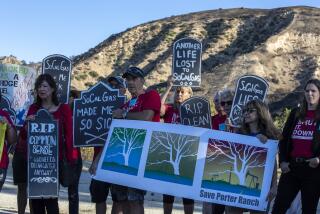Packard Unveils New Offshore Oil Drilling Plan
- Share via
CARLSBAD — Rep. Ron Packard (R-Carlsbad) on Thursday unveiled an alternate plan for oil-tract leasing off the coast of northern San Diego County that would open up for exploration 45 square miles of ocean bottom off Camp Pendleton, just a few miles south of San Clemente.
The plan, announced by Packard at a morning press conference, is a modification of a compromise crafted during recent negotiations between several of the state’s coastal congressmen and Interior Secretary Donald P. Hodel.
Under the secretary’s proposal, which has sparked a storm of protest in Orange and San Diego counties, oil companies would have access to five tracts, each nine square miles, that are three to 25 miles offshore and extend south from the northern edge of Oceanside to Leucadia.
Packard’s alternative, which is being considered by Hodel, would push the five tracts farther north along the coast to a stretch of federal waters extending roughly from the San Onofre nuclear power plant to the Aliso Creek rest area along Interstate 5.
Relax Moratorium
The compromise agreement reached last month would relax a four-year congressional moratorium on oil exploration off the California coast, permitting drilling in 150 ocean-bottom tracts. In return, exploration would essentially be banned until after the year 2000 in 6,300 other tracts now covered by the moratorium.
Most of the 150 tracts are off the coast of the far northern part of the state, but six of them are off Huntington Beach, Newport Beach and Laguna Beach, and 22 are in outer Santa Monica Bay.
Packard’s proposal also would move the majority of the San Diego County tracts farther offshore--many of them out of sight from shore--and recommends conditions for safety, air quality, placement of rigs and sharing of revenue with local governments.
Packard, asserting that he would prefer that there be no drilling off northern San Diego County, billed his alternate plan as an effort to move operations as far from populated areas as possible should the local leasing of tracts become inevitable.
He noted that several tracts targeted for exploration under Hodel’s plan are in waters heavily used by the Marine Corps during amphibious training exercises. The site of the alternate tracts is north of the training zone and has won the verbal approval of military officials, Packard said.
‘Political Realities Clear’
“I’ve worked very hard to keep any drilling from occurring in North County waters,” Packard said. “But the political scenario has made that impossible. The political realities are clear, and I cannot block oil drilling and exploration if my colleagues intend to move ahead.”
Packard said he is confident that Hodel will endorse his set of leasing sites. But he added that the compromise to ease the moratorium and open only 150 offshore tracts is “fragile” because of mounting pressure on the Reagan Administration from the oil industry and its friends in Congress.
(The moratorium, which covers 37.2 million acres off the California coast and expires Oct. 1, has become unpopular in recent years with representatives of inland states. They have charged that coastal states are shirking their share of the responsibility for the nation’s energy needs. Packard has said that expecting the moratorium to continue is “an impossible dream.”)
Mixed Reactions
Local officials and residents had mixed reactions to Packard’s proposal, although most agreed that moving the tracts north would at least reduce the visual impact of drilling operations.
Carlsbad Mayor Mary Casler, calling the eventual placement of oil rigs off the North County coast “all but inevitable,” said that “with certain modifications, I could accept this compromise.”
Jay Powell, conservation coordinator for the Sierra Club’s San Diego chapter, called the proposed northward shift of tracts “a deliberate move along the out-of-sight, out-of-mind theory. If they’re planning rigs off the coast of a desolate Marine base, they’re not likely to get the same clamor as if they stretched all the way down to Leucadia.”
More to Read
Sign up for Essential California
The most important California stories and recommendations in your inbox every morning.
You may occasionally receive promotional content from the Los Angeles Times.













